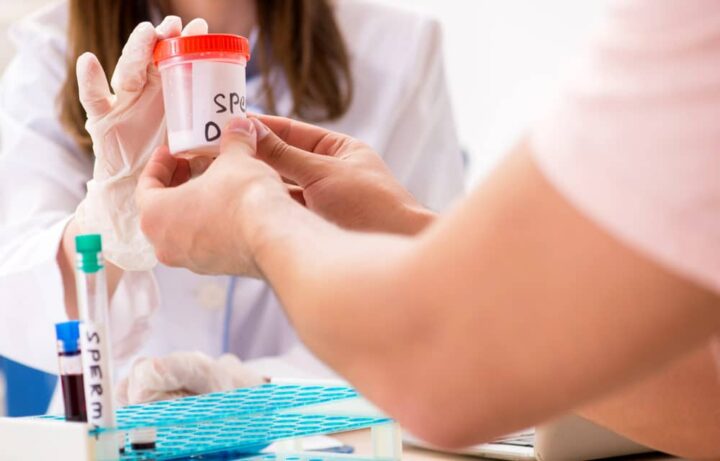What is semen analysis?
Semen analysis is the laboratory testing of freshly ejaculated semen. Under a microscope, the number, shape and movement of sperm are measured. A semen analysis is a vital part of diagnosing male infertility.
When is semen analysis done?
When a couple is having medical investigations for infertility, testing of the male partner will usually include semen analysis. It is also used to confirm a successful vasectomy.
Do I need a referral from a doctor to have a semen analysis?
Your local doctor (GP) can give you a referral to have a semen analysis at a pathology laboratory, many of whom charge a fee above that covered by Medicare. More specialised laboratories, such as those associated with IVF programs, perform more extensive testing. You can find out the out-of pocket costs for semen analysis by contacting the laboratory doing the analysis.
Where is semen analysis done?
Testing should be done at a specialised laboratory that uses methods approved by the World Health Organization (WHO); special equipment and expertise are needed to do an accurate semen analysis.
What is included in a semen analysis?
A number of different elements are tested and recorded in a semen analysis report (see table below).
How is semen collected for testing?
Semen testing should be done on a fresh semen sample (within one hour of being produced). A semen sample is best collected in a specimen jar by masturbation. If ejaculation by masturbation is difficult, semen may be collected by interrupted intercourse. Condom collection devices are available from specialised laboratories; ordinary condoms cannot be used because they usually contain agents that interfere with sperm motility (movement). Semen is usually collected in a private room at the testing laboratory. When semen is collected at home the sample must be kept warm and taken to the laboratory very quickly – if possible within one hour.
It is important that none of the semen sample is lost. As sperm are mostly in the first part of the ejaculate, losing the first part of the ejaculate can falsely lower the sperm concentration. It is also important that the man does not ejaculate for at least two days before the sample is collected. But it is equally important that it should not be longer than seven days since he last ejaculated.
The quality of a man’s semen can differ between samples, even in fertile men. Sperm concentration can be affected by illness; fevers and infections can lower sperm concentration for up to several months.
At least two semen analyses, at least six weeks apart, are needed to properly check fertility.
| ELEMENTS OF A SEMEN ANALYSIS REPORT | ||
| Element | Definition | Reference Range |
| Semen volume | The total amount of fluid ejaculated | ≥1.5 mL |
| Sperm concentration (commonly known as ‘sperm count’) | The number of sperm in a measured volume of the ejaculate is counted. The sperm concentration is reported as the number of sperm per mL of semen. | ≥15 million per mL |
| Total sperm number (also known as ‘total sperm count’) | The total number of sperm in the ejaculate, calculated by multiplying the semen volume by the sperm. | ≥39 million |
| Sperm motility (the ability of sperm to swim or move forward) | The number of motile (moving) sperm is compared to the number of non-motile sperm and is reported as a percentage of the total number of sperm. | ≥40% motile within 60 minutes of ejaculation |
| Sperm vitality (‘live’sperm) | The number of sperm in the sample that are ‘alive’ as a percentage of the total number of sperm. | ≥58% |
| Sperm morphology (the shape of the sperm) | The number of ideally shaped sperm (referred to as ‘normal’) is compared to the number of imperfectly shaped sperm (often referred to as ‘abnormal’), reported as a percentage of the total number of sperm. | ≥4% |
| White blood (inflammatory) cells | Often found in the semen. Large numbers of white blood cells in the ejaculate can be a sign of an infection of the reproductive tract. However, in some healthy men it happens for no known reason. | <1 million per mL |
| Semen pH | Measured to test if the ejaculate is acidic or alkaline. Semen should be slightly alkaline. More acidic semen, together with a low amount (volume) of semen, may mean there is a blockage in the flow of semen. | ≥7.2 |
| Sperm antibodies | Normally done in specialised laboratories using methods approved by the World Health Organization. | <50% motile sperm showing antibody activity |
How do the shape and physical features of sperm affect fertility?
Defects in the shape of the sperm heads or tails can affect movement and the sperm’s ability to bind to and fertilise an egg. When checked using correct WHO methods, the morphology (shape) result is a marker of sperm function, that is, it can indicate the sperm’s chance of fertilising an egg.
It is quite common for fertile men to have a low percentage of ideally shaped sperm; however, when the proportion of ideally shaped sperm is less than four per cent of the total sperm the chance of being fertile is lower, particularly if there are no ideally shaped sperm present.
It’s important to note that having sperm that are not an ideal shape is not linked with problems in the baby if the man becomes a father.
What are sperm antibodies?
Sperm antibodies happen in some men when the immune system reacts to the man’s own sperm as if it were foreign tissue. About four in five men develop sperm antibodies after having a vasectomy.
Can sperm antibodies cause infertility?
In most men sperm antibodies do not cause any problems and will not affect the chance of a pregnancy. However, in a small number of men sperm antibodies can lower fertility in the following ways: by reducing the number of sperm in the semen; by coating sperm and making them clump together, which reduces their motility (movement), and may stop the sperm from swimming through the fluid in a woman’s cervix and reproductive tubes; and by stopping the sperm binding to and penetrating the egg during fertilisation.
What do the results of the semen analysis mean?
The World Health Organization (WHO, 2010) published reference values to help work out how an individual semen analysis result compares to a population of fertile men. A semen analysis within the reference range does not guarantee that an individual man is fertile but it gives a guide as to whether the man is likely to be fertile. There may be other reasons for a man’s infertility that are not shown by a semen analysis.
In the same way, men who have a very low sperm concentration and are not within these reference ranges might still be able to get a partner pregnant naturally. So, for example, while 15 million sperm per mL is the lower reference value for sperm concentration, this does not mean that men with 2 million sperm per mL are always infertile. About 30 per cent of such couples will have a spontaneous pregnancy over a two to three-year period.
In addition to semen quality, other factors that can affect the couple’s chance of getting pregnant include the couple’s frequency and timing of sex, the length of time the couple has tried to get pregnant, and the age and fertility of the female partner.
A man’s semen analysis needs to be used together with other clinical information by the doctor. It is important to remember that a couple’s chance of getting pregnant, and the time it takes to become pregnant, is also affected by the female partner’s fertility.
Are other tests done as part of a semen analysis?
In some cases, men may need to provide a urine sample after ejaculation if the doctor thinks there is retrograde ejaculation (ejaculation back into the bladder). The urine is checked for sperm.
In severely infertile men, sperm DNA may be damaged which lowers the chance of the sperm making a healthy embryo and live-born baby. Different methods for testing sperm DNA damage are available; however, more research is needed to decide the place of these tests in routine clinical practice and they are not recommended in most professional guidelines.
Visit healthymale.org.au or speak to your doctor for more info.
EXPERT REVIEWER
Professor Rob Mclachlan, AM MBBS FRACPS PhD
Healthy Male (Medical Director)
DATE REVIEWED: FEBRUARY 2018
The information in this fact sheet has been provided for educational purposes only. It is not intended to take the place of a clinical diagnosis or proper medical advice from a fully qualified health professional. Healthy Male urges readers to seek the services of a qualified medical practitioner for any personal health concerns.
https://healthymale.org.au/mens-health/semen-analysis
© Healthy Male (Andrology Australia) 2018





